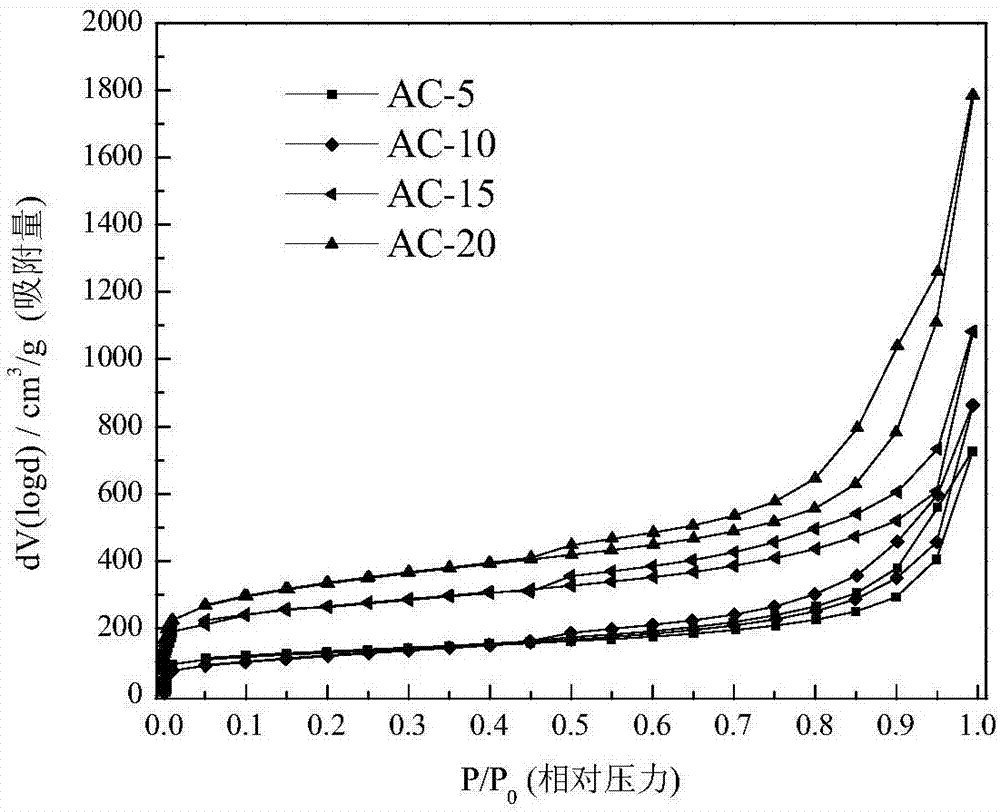Method for preparing polyester textile waste-based activated carbon by using bittern solution as a templating-chemical activating agent
A technology of chemical activator and textile waste, applied in the direction of chemical instruments and methods, inorganic chemistry, other chemical processes, etc., can solve the problems of cumbersome preparation process, single pore size distribution, high cost of raw materials, etc.
- Summary
- Abstract
- Description
- Claims
- Application Information
AI Technical Summary
Problems solved by technology
Method used
Image
Examples
Embodiment 1
[0041] A kind of method utilizing template-chemical activation method to prepare polyester textile waste-based activated carbon, specifically comprises steps as follows:
[0042] (1) Pretreatment of polyester textile waste
[0043] Wash and dry the polyester textile waste, cut it into small pieces of 1cm×1cm, put it in a muffle furnace at a controlled temperature of 260°C, and stay there for 0.5h until it melts. After it cools down naturally, put it in an agate mortar and grind it into powder to obtain polyester powder;
[0044] The polyester powder obtained above has ash content of 0.52%, volatile content of 88.39%, fixed carbon content of 10.71%, and percentages of C, H, O, N, and S elements in the polyester powder are 63.51%, 5.11%, and 24.12% respectively. %, 6.43%, 0.11%;
[0045] (2), brine dipping
[0046] Pour 3g of the polyester powder obtained in step (1) into 60mL of bittern solution, and mix evenly in a mixer with a rotational speed of 100r / min, then place it st...
Embodiment 2
[0052] A kind of method utilizing template-chemical activation method to prepare polyester textile waste-based activated carbon, specifically comprises steps as follows:
[0053] (1) Pretreatment of polyester textile waste
[0054] Wash and dry the polyester textile waste, cut it into small pieces of 1cm×1cm, put it in a muffle furnace at a controlled temperature of 260°C, and stay there for 0.5h until it melts. After it cools down naturally, put it in an agate mortar and grind it into powder to obtain polyester powder;
[0055] The polyester powder obtained above has ash content of 0.52%, volatile content of 88.39%, fixed carbon content of 10.71%, and percentages of C, H, O, N, and S elements in the polyester powder are 63.51%, 5.11%, and 24.12% respectively. %, 6.43%, 0.11%;
[0056] (2), brine dipping
[0057] Pour 3g of the polyester powder obtained in step (1) into 45mL of bittern solution, and mix evenly in a mixer with a rotational speed of 100r / min, then place it st...
Embodiment 3
[0064] A kind of method utilizing template-chemical activation method to prepare polyester textile waste-based activated carbon, specifically comprises steps as follows:
[0065] (1) Pretreatment of polyester textile waste
[0066] Wash and dry the polyester textile waste, cut it into small pieces of 1cm×1cm, put it in a muffle furnace at a controlled temperature of 260°C, and stay there for 0.5h until it melts. After it cools down naturally, put it in an agate mortar and grind it into powder to obtain polyester powder;
[0067] The polyester powder obtained above has ash content of 0.52%, volatile content of 88.39%, fixed carbon content of 10.71%, and percentages of C, H, O, N, and S elements in the polyester powder are 63.51%, 5.11%, and 24.12% respectively. %, 6.43%, 0.11%;
[0068] (2), brine dipping
[0069] Pour 3g of the polyester powder obtained in step (1) into 30mL of bittern solution, and mix evenly in a mixer with a rotational speed of 100r / min, then place it st...
PUM
| Property | Measurement | Unit |
|---|---|---|
| Specific surface area | aaaaa | aaaaa |
| Maximum adsorption capacity | aaaaa | aaaaa |
| Removal rate | aaaaa | aaaaa |
Abstract
Description
Claims
Application Information
 Login to View More
Login to View More - Generate Ideas
- Intellectual Property
- Life Sciences
- Materials
- Tech Scout
- Unparalleled Data Quality
- Higher Quality Content
- 60% Fewer Hallucinations
Browse by: Latest US Patents, China's latest patents, Technical Efficacy Thesaurus, Application Domain, Technology Topic, Popular Technical Reports.
© 2025 PatSnap. All rights reserved.Legal|Privacy policy|Modern Slavery Act Transparency Statement|Sitemap|About US| Contact US: help@patsnap.com



